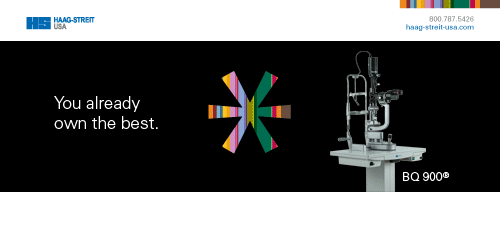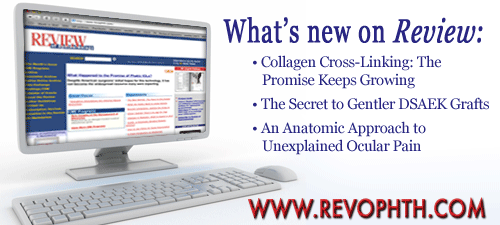
|
|
Volume 10, Number 38 |
Monday, September 27, 2010 |
 |
||
 |
||
|
Isometric Exercise and Choroidal Blood Flow in Patients with AMD
To investigate choroidal vascular regulation in age-related macular degeneration (AMD), the regulatory responses induced by isometric exercise in control subjects and patients with AMD were compared. The study results suggest that the response of the choroidal circulation to this type of isometric exercise resulting in a moderate increase in blood pressure does not seem to be affected by AMD.
Included in this study were 17 eyes of 17 patients with dry AMD in the study eye and 19 eyes of 19 controls. Both groups were well matched for age, race and sex. Brachial artery blood pressure determinations and laser Doppler flowmetry (Oculix) measurements of relative foveolar choroidal blood velocity, volume and flow were obtained in the study eye of each subject during 30 x of baseline, and then during 3 min of isometric exercise consisting of squeezing a handgrip in each hand. It was reported that similar measurements were then also obtained during the 2 min following the cessation of exercise and using non-paired, two-tailed t test, changes in circulatory parameters during exercise and following the end of exercise were compared between AMD patients and control subjects. Additionally, the slop for the relationship between circulatory changes and perfusion pressure changes was calculated and compared between patients with AMD and controls using linear regression analysis. Analysis of data was performed in a masked fashion. No statistically significant differences between the changes in choroidal blood velocity, volume and flow were observed in control subjects and patients with AMD during the isometric exercise phase and after exercise. | |
|
SOURCE: Metelitsina TI, Grunwald JE, DuPont JC, Ying GS. Effect of isometric exercise on choroidal blood flow in patients with age-related macular degeneration. Br J Ophthalmol 2010;Sept 13 [Epub ahead of print]. |
 |
| |||||||
|
Symptomatic Dry Eye and Its Influence on Vision-Related Daily Activities
The authors of this population-based survey of eye diseases sought to examine the impact of symptomatic dry eye on vision-related daily activities in 3,280 (78.7% response rate) Malay persons aged 40 years, who were randomly selected from designated areas in southwestern Singapore. They administered to participants a standardized dry eye questionnaire consisting of six questions on symptoms and a questionnaire on vision-related daily activities; they also conducted a comprehensive systemic and ocular examination of participants. The authors defined symptomatic dry eye as one or more self-reported symptoms that were frequently present (ranked as often or all the time) and used logistic regression method to examine the relationship of symptomatic dry eye with difficulty in performing daily activities. They reported that in adults without visual impairment, symptomatic dry eye after adjusting for age, gender and presenting visual acuity was significantly associated with difficulty in vision-related activities such as navigating stairs (odds ratio [OR]=1.96, 95% confidence interval [CI]: 1.28–3.00), recognizing friends (OR=1.99, 95% CI: 1.45–2.73), reading road signs (OR=1.87, 95% CI: 1.36–2.57), reading newspaper (OR=1.50, 95% CI: 1.11–2.04), watching television (OR=1.90, 95% CI: 1.26–2.87), cooking (OR=1.94, 95% CI: 1.02–3.71) and driving at night (OR=2.06, 95% CI: 1.32–3.21). To conclude, the authors associated symptomatic dry eye with difficulty in performing vision-dependent tasks, independent of visual acuity and other factors. These findings have public health significance and suggest that the visual dysfunction in dry eye should be further characterized. | |
|
SOURCE: Tong L, Waduthantri S, Wong TY, et al. Impact of symptomatic dry eye on vision-related daily activities: The Singapore Malay Eye Study. Eye 2010;24(9):1486–1491. |
 |
 |
||
|
Relationship of AMD with Polymorphisms in VEGF and its Receptor
Italian investigators sought to analyze the association between age-related macular degeneration (AMD) and polymorphisms in vascular endothelial growth factor (VEGF) and VEGF receptor KDR gene polymorphisms in this case-control study. They note that previous investigated the possible association between VEGF-A gene polymorphisms and AMD, with contrasting data, but that no study examined the possible role of VEGF receptor KDR gene polymorphisms. The study investigators enrolled 226 AMD cases and 148 controls from an ophthlamology hospital center and employed genotyping for 16 polymorphic markers (single nucleotide polymorphisms [SNPs] in VEGF-A and KDR genes. Main outcome measures were distribution of genotypes in AMD cases and controls. Two polymorphisms (rs833069 in intron 2 of the VEGF-A gene, rs2071559 in the promoter of the KDR gene) were significantly associated with risk of AMD, according to the investigators. In particular, for VEGF-A rs833069 the AMD risk was increased >5-fold for G homozygotes compared with homozygous carriage of the A allele, they found. For KDR rs2071559, the AMD risk was increased >3-fold for T homozygotes compared with homozygous carriage of the C allele. The investigators determined that carriers of risk alleles for both markers have a >6-fold increased risk of AMD with respect to carriers of non-risk alleles. They report that their study expands previous data on the association of AMD with VEGF-A gene variations and identifies for the first time an association with variations in the KDR gene. Because the SNP-604T-bearing KDR promoter has higher transcription activity, their findings further support the role of the VEGF pathway in the pathophysiology of AMD. The investigators conclude that it is possible that applications of haplotype/genotype analysis in these genes will play a role in risk assessment and pharmacogenomic approaches to AMD diagnosis and management. | |
|
SOURCE: Galan A, Ferlin A, Caretti L, et al. Association of age-related macular degeneration with polymorphisms in vascular endothelial growth factor and its receptor. Ophthalmol 2010;117(9):1769–1774. |
 |
 |
||
|
Evaluating Stereoscopic Color Fundus Photographs and Fluorescein Angiograms Using Standard Care vs Corticosteroid for Retinal Vein Occlusion (SCORE) Study System
In this paper, researchers sought to describe the procedures and reproducibility for grading stereoscopic color fundus photographs and fluorescein angiograms of participants in the SCORE Study and found that such grading procedures are reproducible and can be used for multicenter longitudinal studies of RVO. They also found that a systematic temporal drift occurred in evaluating area of retinal thickening. Standardized stereoscopic fundus photographs and fluorescein angiograms taken at 84 clinical centers were evaluated by graders at a central reading center, the researchers noted. Type of retinal vein occlusion (RVO), area of retinal thickening and area of retinal hemorrhage are evaluated from fundus photographs; area of fluorescein leakage and area of capillary nonperfusion are measured on fluorescein angiography. The researchers reported that temporal reproducibility consisted of annual regrading of a randomly selected dedicated subset of fundus photographs (60 subjects) and fluorescein angiograms (40 subjects) for three successive years. Contemporaneous reproducibility involved monthly regarding of a 5% random selection of recently evaluated fundus photographs (n=73). According to the study researchers, the intergrader agreement for RVO type and presence of retinal thickening was greater than 90% in the three annual regrades. They also observed that the intraclass correlation (ICC) for area of retinal thickening in the 3 years ranged from 0.39 to 0.64 and for area of retinal hemorrhage, 0.87 to 0.96. Furthermore, the ICC for area of fluorescein leakage ranged from 0.66 to 0.75 and for capillary nonperfusion, 0.94 to 0.97. The contemporaneous reproducibility results were similar to those of temporal reproducibility for all variables except area of retinal thickening (ICC, 0.84). | |
|
SOURCE: Blodi BA, Domalpally A, Scott IU, et al. Standard care vs corticosteroid for retinal vein occlusion (SCORE) study system for evaluation of stereoscopic color fundus photographs and fluorescein angiograms. Arch Ophthalmol 2010;128(9):1140–1145. |
 |

| |
|
|
 |
| Subscriptions: Review of Ophthalmology Online is provided free of charge as a service of Jobson Professional Publications Group, a division of Jobson Medical Information LLC, 11 Campus Blvd., Newtown Square, PA 19073. If you enjoy reading Review of Ophthalmology Online, please tell a friend or colleague about it. Forward this newsletter or go to
www.jobson.com/globalemail/ and sign up today. To change your subscription, reply to this message and give us your old address and your new address; type "Change of Address" in the subject line. If you do not want to receive Review of Ophthalmology Online,
click here.
Advertising: For information on advertising in this e-mail newsletter or other creative advertising opportunities with Review of Ophthalmology, please contact publisher Rick Bay, or sales managers James Henne, Michele Barrett or Kimberly McCarthy. News: To submit news, send an e-mail, or FAX your news to 610.492.1049 |













